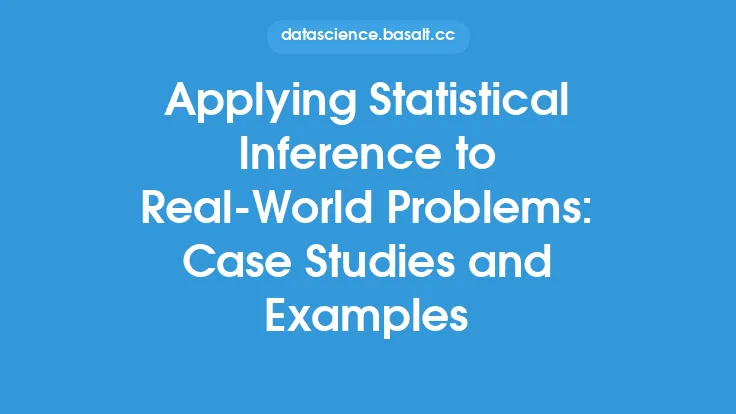Probability theory has numerous applications in real-world scenarios, making it a fundamental tool for decision-making under uncertainty. The theory provides a mathematical framework for analyzing and modeling random events, allowing us to make informed decisions in a wide range of fields, including finance, engineering, medicine, and social sciences. In this article, we will explore several case studies and illustrations that demonstrate the power and versatility of probability theory in real-world scenarios.
Introduction to Real-World Applications
Probability theory has been successfully applied to various real-world problems, including risk analysis, quality control, and predictive modeling. For instance, in finance, probability theory is used to model stock prices, credit risk, and portfolio optimization. In engineering, probability theory is used to design and optimize systems, such as communication networks, transportation systems, and power grids. In medicine, probability theory is used to model the spread of diseases, optimize treatment strategies, and predict patient outcomes.
Case Study: Insurance Industry
The insurance industry is a prime example of how probability theory is used in real-world scenarios. Insurance companies use probability theory to calculate premiums, assess risk, and predict claim frequencies. For instance, actuaries use probability distributions, such as the Poisson distribution, to model the number of claims filed by policyholders. They also use Bayesian inference to update their estimates of claim frequencies based on new data. By applying probability theory, insurance companies can optimize their pricing strategies, manage risk, and provide better services to their customers.
Case Study: Medical Diagnosis
Probability theory is also widely used in medical diagnosis. For instance, doctors use Bayesian inference to update their estimates of disease probabilities based on new diagnostic test results. They also use probability theory to model the spread of diseases, predict patient outcomes, and optimize treatment strategies. For example, in cancer diagnosis, doctors use probability theory to model the likelihood of cancer given a set of symptoms and test results. They also use probability theory to predict the effectiveness of different treatment strategies, such as surgery, chemotherapy, or radiation therapy.
Case Study: Quality Control
Probability theory is used in quality control to monitor and improve the quality of products. For instance, manufacturers use statistical process control (SPC) to monitor the quality of their products and detect any deviations from the norm. SPC uses probability theory to model the distribution of quality characteristics, such as mean and variance, and to detect any anomalies. By applying probability theory, manufacturers can optimize their production processes, reduce defects, and improve customer satisfaction.
Case Study: Finance
Probability theory is widely used in finance to model stock prices, credit risk, and portfolio optimization. For instance, the Black-Scholes model uses probability theory to model the price of options and other derivatives. The model assumes that stock prices follow a geometric Brownian motion, which is a continuous-time stochastic process. By applying probability theory, investors can optimize their investment strategies, manage risk, and predict potential returns.
Case Study: Engineering
Probability theory is used in engineering to design and optimize systems, such as communication networks, transportation systems, and power grids. For instance, engineers use probability theory to model the reliability of systems, predict failure rates, and optimize maintenance strategies. They also use probability theory to model the uncertainty associated with system parameters, such as demand, capacity, and failure rates. By applying probability theory, engineers can optimize system design, reduce costs, and improve performance.
Conclusion
In conclusion, probability theory has numerous applications in real-world scenarios, making it a fundamental tool for decision-making under uncertainty. The theory provides a mathematical framework for analyzing and modeling random events, allowing us to make informed decisions in a wide range of fields, including finance, engineering, medicine, and social sciences. By applying probability theory, we can optimize systems, manage risk, and predict potential outcomes. The case studies and illustrations presented in this article demonstrate the power and versatility of probability theory in real-world scenarios, highlighting its importance in modern decision-making.
Future Directions
Future research in probability theory is expected to focus on developing new methods and models for analyzing and modeling complex systems. For instance, researchers are exploring the use of machine learning and artificial intelligence to improve predictive modeling and decision-making under uncertainty. They are also developing new probability distributions and models to capture the complexity and uncertainty associated with real-world systems. Additionally, researchers are applying probability theory to new fields, such as climate modeling, epidemiology, and social network analysis. By advancing the field of probability theory, we can develop new tools and methods for analyzing and modeling complex systems, leading to better decision-making and improved outcomes.
Technical Details
From a technical perspective, probability theory is based on a set of axioms and definitions that provide a mathematical framework for analyzing and modeling random events. The theory uses probability distributions, such as the normal distribution, Poisson distribution, and binomial distribution, to model the uncertainty associated with random events. It also uses statistical inference, such as Bayesian inference and maximum likelihood estimation, to update estimates of model parameters based on new data. Additionally, probability theory uses stochastic processes, such as Markov chains and Brownian motion, to model the dynamics of complex systems. By applying these technical tools and methods, we can develop new models and methods for analyzing and modeling real-world systems, leading to better decision-making and improved outcomes.
Illustrations and Examples
To illustrate the concepts and methods of probability theory, consider the following example. Suppose we want to model the number of customers arriving at a store per hour. We can use the Poisson distribution to model the number of arrivals, assuming that the arrivals occur independently and at a constant rate. We can then use Bayesian inference to update our estimates of the arrival rate based on new data. For instance, if we observe 10 customers arriving in the first hour, we can update our estimate of the arrival rate using Bayes' theorem. This example illustrates the use of probability theory in modeling and analyzing real-world systems, highlighting its importance in modern decision-making.
Comparison with Other Fields
Probability theory is closely related to other fields, such as statistics, mathematics, and computer science. Statistics provides a set of tools and methods for analyzing and modeling data, while mathematics provides a set of axioms and definitions that underlie probability theory. Computer science provides a set of algorithms and models for simulating and analyzing complex systems. By combining probability theory with these fields, we can develop new models and methods for analyzing and modeling real-world systems, leading to better decision-making and improved outcomes. For instance, we can use machine learning and artificial intelligence to improve predictive modeling and decision-making under uncertainty. We can also use statistical inference and mathematical modeling to develop new probability distributions and models that capture the complexity and uncertainty associated with real-world systems.





